ISSN ONLINE(2319-8753)PRINT(2347-6710)
ISSN ONLINE(2319-8753)PRINT(2347-6710)
| Parul, B.D.Vashistha Department of Botany, Kurukshetra University, Kurukshetra-136119, Haryana, India |
| Related article at Pubmed, Scholar Google |
Visit for more related articles at International Journal of Innovative Research in Science, Engineering and Technology
Yamuna Nagar district of Haryana is very less explored for ethnobotanical studies. Therefore many survey of Yamuna Nagar district have been conducted for the documentation of ethnobotanical data and exploration of floristic diversity during the year 2011-2012.Field surveys were carried out throughout the district to collect etnobotanical data (traditional use of plants, local name, plant parts used, medicinal value). Over all 73 species of flowering plants were collected during the field survey, out of which 46 species of ethnobotanical value belonging to 42 genera and 26 families have been recorded. Among all families,Leguminosae and Solanaceae are the more dominant. Most commonly used plant parts are leaves 30.43%, whole plants 26.08%, fruits 13.04%, bark 17.39%, seed 21.73%, roots 10.86%, flowers 8.70% and others 10.86%. They are used by the rural peoples for the treatment of various disease like diarrhoea, dysentery, male and female sexual diseases, cardiovascular diseases, headache, asthma, toothache, acne, diabetes, gonorrhoea, skin disease, kidney stone, hyperthyroidism, piles, cancer.
Keywords |
| Ethnobotany, Yamuna nagar, Field survey, Plant parts, Medicinal plants, Haryana, India |
INTRODUCTION |
| Ethnobotany word is made from two words ethno and botany and the term was coined by John William Harshberger in the 1890. Ethnobotany is the study of people and study of plants; this is represented good relationship between wild plants (Herbs, Shrubs and Trees) and tribal’s. Ethnobotany is the branch of Ethnobiology and complete information about plants and their medicinal uses is given by ethnobotanicalstudies [1]. Plants represent an enormous pool of natural resources that can produce various products and chemicals for the advantage of all other life forms and ethnobotany reveals historical and present plant use to fulfil a wide variety of human needs, so the documentation of ethnobotanical knowledge is important for species conservation and sustainable use of resources. Furthermore, such studies are often significant in revealing locally important plant species, sometimes leading to the discovery of crude drugs [2], [3]. |
| The World Health Organization (W.H.O.) reported that 80 % of the world population rely chiefly on indigenous medicine and that the majority of traditional therapies involve the use of plant extracts or of their active constituents [4]. There are over 20,000 species of wild edible plants in the world, yet fewer than 20 species now provide 90% of our food [5]. Utilization of plants for medicinal purposes in India has been documented long back in ancient literature because they are essential for human survival [6]. First record of medicinal plants were recorded in Rig Veda between 4500–1600 BC and Ayurveda between 2500–600BC [7]. According to the National Medicinal Plants Board, Govt. of India, a number of 17,000 to 18,000 species of flowering plants are estimated of which 6,000 to 7,000 species are found to have medicinal usage in folk and documented systems of medicine like Ayurveda, Unani, Siddha and Homoeopathy [8].Because of the fast acceleration of market demand for herbal medicines, and recent controversies related to access, benefit sharing and biopiracy, the documentation of indigenous knowledge is of urgent priority [9]. Manyethnobotanical studies have been conducted by various researchers in different parts of India [9], [10], [11], [12], [13]. However, Yamuna Nagar district of Haryana is very less explored for ethnobotanical studies. Therefore many survey of Yamuna Nagar district have been condu |
MATERIALS AND METHODS |
| STUDY SITE: Yamuna Nagar district was selected for etnobotanical studies and exploration of floristic diversity. Yamuna Nagar is one of 21 districts of Haryana state (India) and lies on the north-eastern edge of Haryana, located between 30° 7′ 58.8″ N and 77° 17′ 16.8″ E. It is bordered by the Saharanpur district of Uttar Pradesh in east, in west by Ambala, in north Sirmour district of Himachal Pradesh, in south by Karnal district and in south west by Kurukshetra (Fig.1). Yamuna Nagar has an area of 1,756 square kilometres. Average annual rainfall is 1400mm and the temperature ranges between -1°C to 45°C, out of which 70% rainfall is received during the month of July to September and the remaining during December to February. Yamuna Nagar has the river Yamuna running through the district. The Yamuna river system separates from the Satluj river system by district Yamuna Nagar. Towards its northern edge is a sub-mountainous region (SiwalikHills), which has more forest cover and lots of streams. Geologically speaking, the Shiwalik belong to the tertiary deposits of the outer Himalayas, and are chiefly composed of low sandstone and conglomerate hills, the solidified and upheaved detritus of the great range.Shiwalik system takes its name from shiwalik hills of Haridwar region between the Ganga and the Yamuna rivers. |
 |
| METHODOLOGY: Many field surveys were conducted in Yamuna Nagar district in different seasons during 2011-12. Standard methods were adopted for collection of voucher specimens, preservation, and for the collection of ethnobotanical information [14]. Photographs of plants were taken in natural habitat. The ethnobotanical data (use of plant, plant parts used, local name) (table-2) was collected through interviews and discussions with herbalists, farmers, spiritualist, in study area. Majority of informant’s were belonged to old age group, who have a very long association with usage of plants. Specimens of all species were identified with the help of available literature [9], [10], [12], [13]. Voucher specimens were prepared and deposited in the herbarium of Botany Department, Kurukshetra University, Kurukshetra (Haryana) India. |
RESULTS AND DISCUSSIONS |
| Over all 73 species of flowering plants were collected during the field survey, out of which 46 species were of ethnobotanical value. These speciesbelonged to 42 genera and 26 families. Among all families ,Leguminosae and Solanaceae ( 4 genera and 5 species each) are the more dominant families followed by Malvaceae, Brassicaceae, Euphorbiaceae (3 genera and 3 species each), Amaranthaceae(2 genera and 3 specie ), Asteraceae, Convolvulaceae, Menispermaceae(2 genera and 2 species each), Moraceae(1genera and 2 species) and 16 families were represented by single genera and single species (Table-1). |
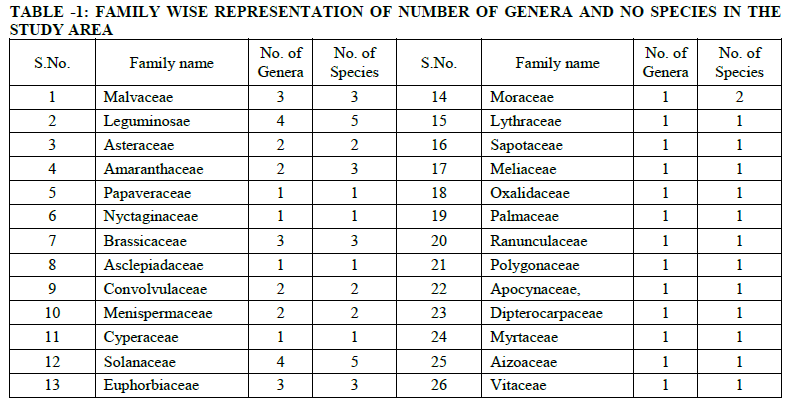 |
| Most commonly used plant parts are leaves 30.43%, whole plants 26.08%, fruits 13.04%, bark 17.39%, seed 21.73%, roots 10.86%, flowers 8.70% and others(latex, gum, stem)10.86%, out of them leaves were the leading part used in majority of medicinal plants(Fig. 2). Plants of different habits i.e. herbs 43.48%, shrub 15.21%, under shrub 8.70%, trees 23.91%, and climber 8.70% were recorded for different ethnomedicinal value, out of them herbs are more prominent shown in Fig.3. |
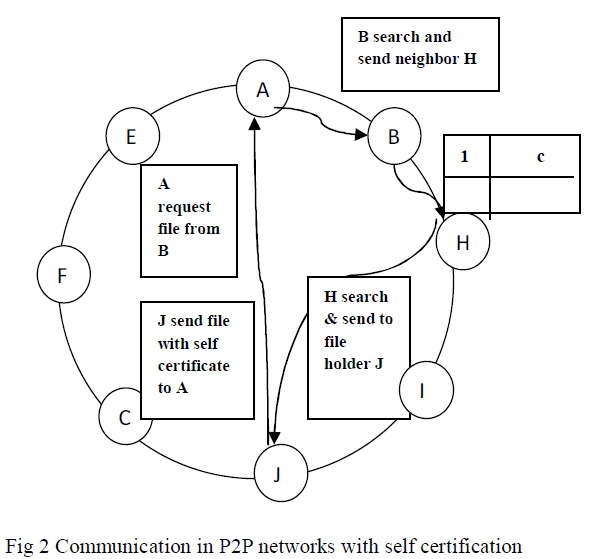 |
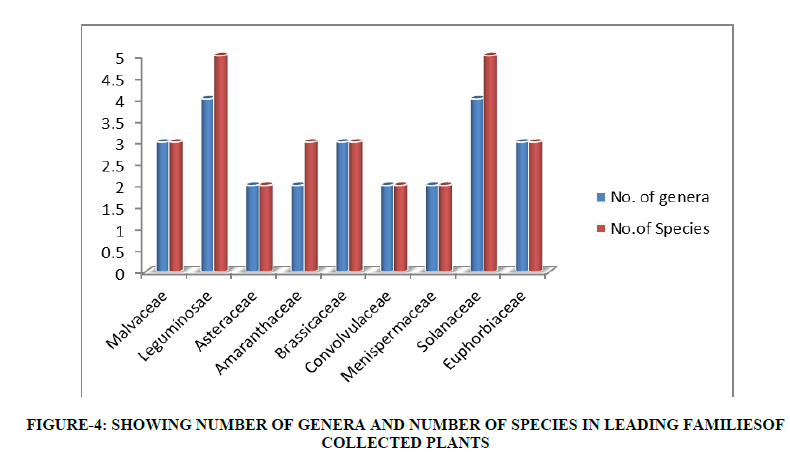 |
| All 26 families were found to contribute for various etnobotanical values, out of them Leguminosae and Solanaceae(4 genera and 5 species each) are the more prominent families followed by Malvaceae, Brassicaceae, Euphorbiaceae(3 genera and 3 species each), Amaranthaceae(2 genera and 3 specie ), Asteraceae, Convolvulaceae, Menispermaceae(2 genera and 2 species each) shown in Fig.4.They are used by the Rural peoples and traditional healers for the treatment of various diseases like diarrhoea, dysentery, male and female sexual disease, cardiovascular disease, headache, asthma, toothache, acne, diuretic, diabetes, gonorrhoea, skin disease, kidney stone, hyperthyroidism,piles and cancer (Table-2). |
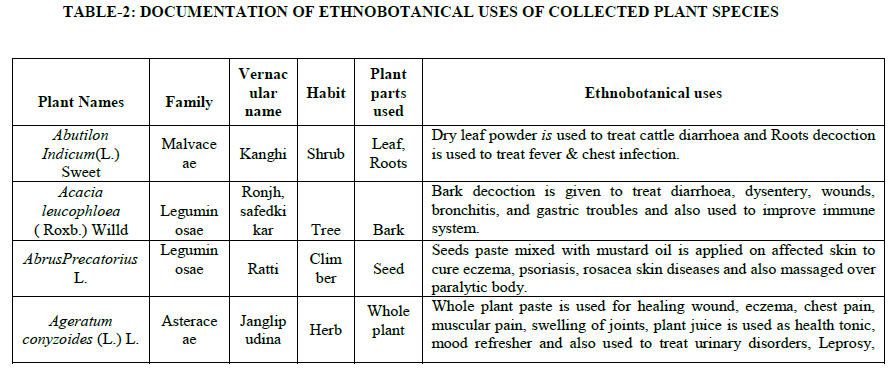 |
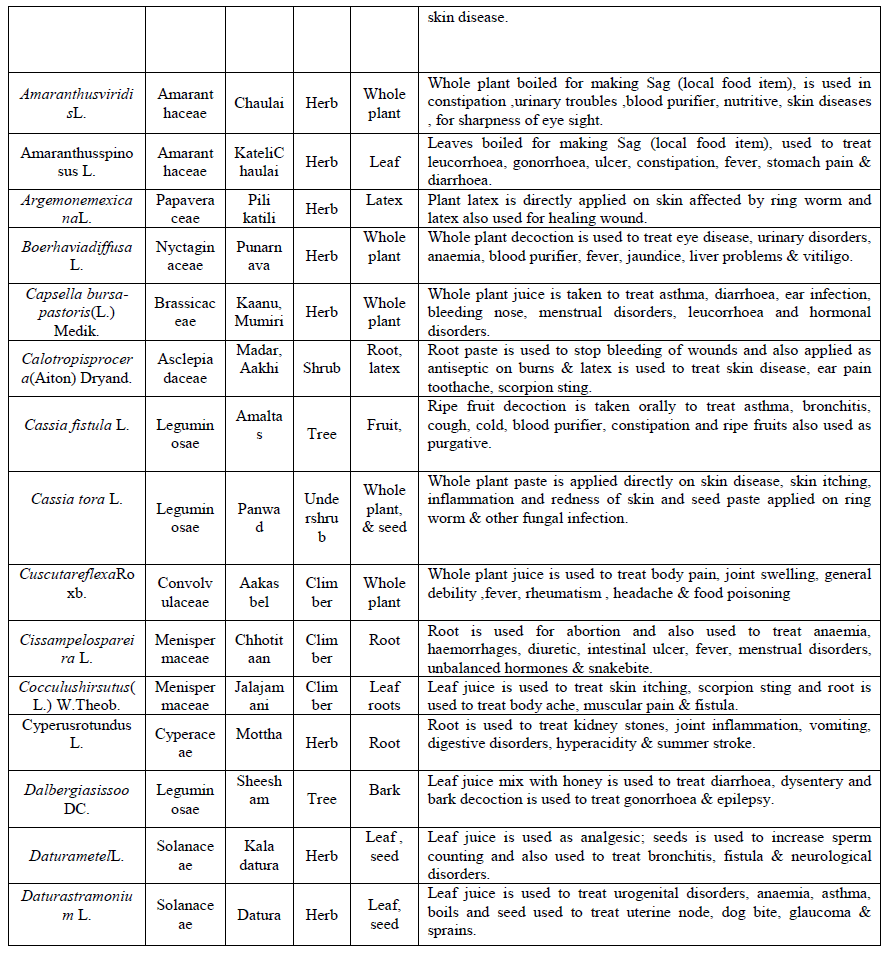 |
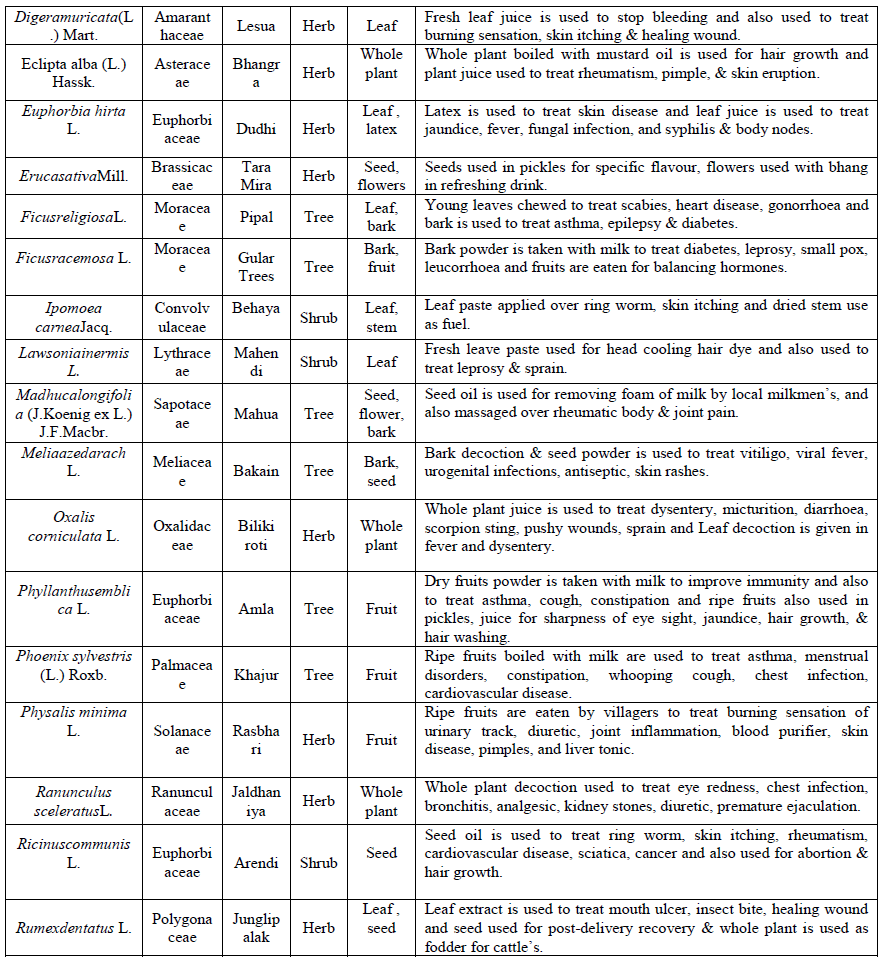 |
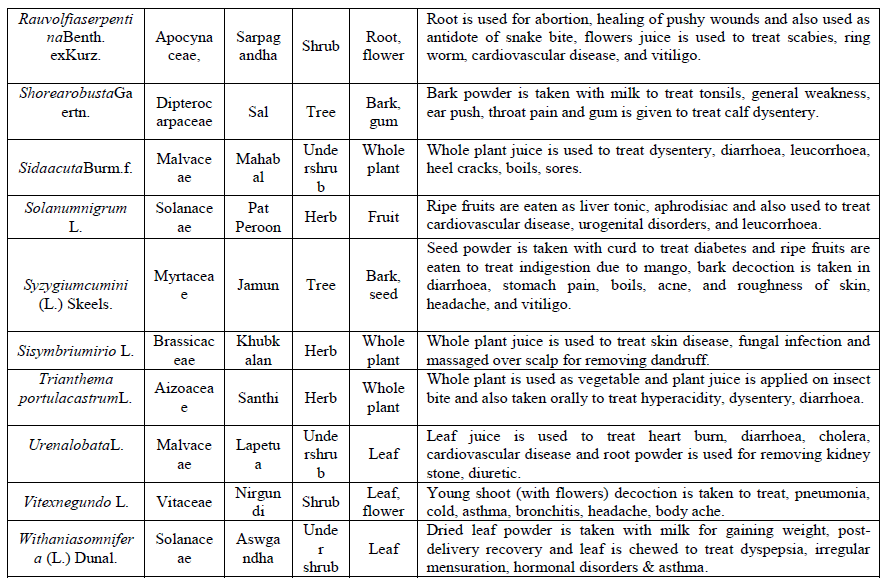 |
CONCLUSION |
| The Floristic and Ethnobotanical survey of Yamuna Nagar district concludes that rural people of district possess rich ethnobotanical knowledge about treatment of various diseases (diarrhoea, dysentery, male and female sexual disease, cardiovascular disease, headache, asthma, toothache, acne, diuretic, diabetes, gonorrhoea, skin disease, kidney stone, hyperthyroidism, piles, and cancer), but this traditional medicinal knowledge is declining with time due to rapid urbanisation and migration of rural people. It thus becomes necessary the documentation of ethnobotanicalknowledge. This study also suggested that documentation of traditional knowledge about plant medicinal uses provides raw material for pharmacological investigation and leading to discovery of various drugs. |
ACKNOWLEDGEMENT |
| Authors are very grateful to rural people, herbalist and spiritualist, farmers for sharing their ethnomedicinal knowledge and laboratory facilities provided by the Botany department,Kurukshetra University,Kurukshetra(Haryana) India. We are also thankful to Dr.Nidhansingh for helping us in identification of wild plants. |
References |
|